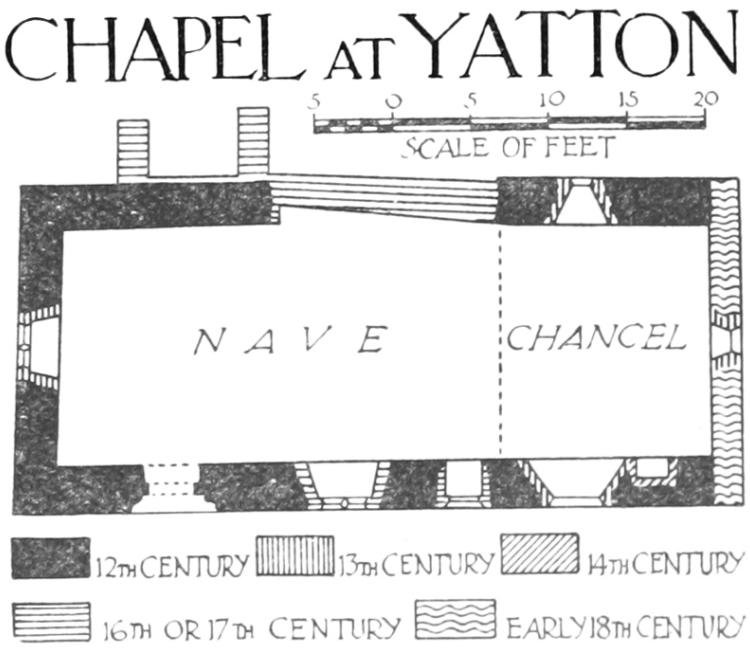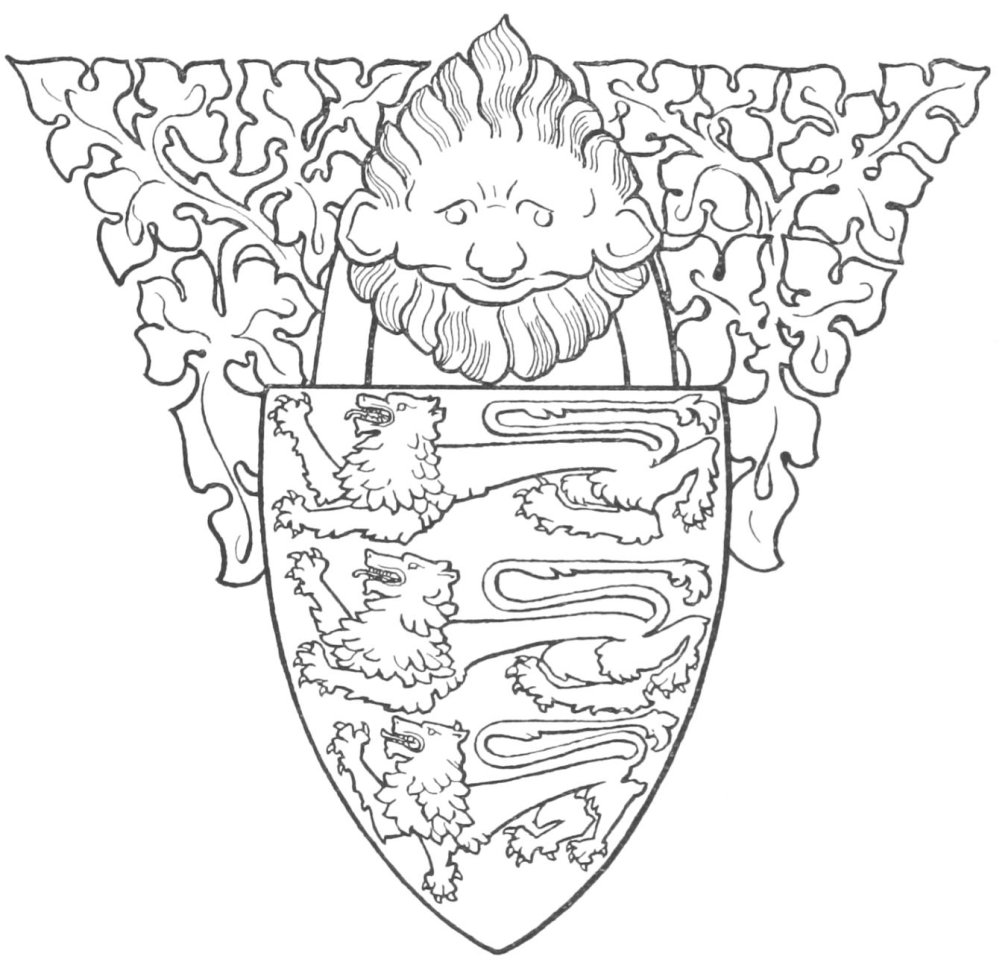An Inventory of the Historical Monuments in Herefordshire, Volume 2, East. Originally published by His Majesty's Stationery Office, London, 1932.
This free content was digitised by double rekeying. All rights reserved.
'Yatton', in An Inventory of the Historical Monuments in Herefordshire, Volume 2, East(London, 1932), British History Online https://prod.british-history.ac.uk/rchme/heref/vol2/pp225-227 [accessed 19 April 2025].
'Yatton', in An Inventory of the Historical Monuments in Herefordshire, Volume 2, East(London, 1932), British History Online, accessed April 19, 2025, https://prod.british-history.ac.uk/rchme/heref/vol2/pp225-227.
"Yatton". An Inventory of the Historical Monuments in Herefordshire, Volume 2, East. (London, 1932), British History Online. Web. 19 April 2025. https://prod.british-history.ac.uk/rchme/heref/vol2/pp225-227.
In this section
97 YATTON (C.e.)
(O.S. 6 in. XLVII, N.W.)
Yatton is a small parish 4½ m. N.E. of Ross. The disused chapel, dating from the 12th century, and Dean's Place are the principal monuments.
Ecclesiastical
(1). Chapel of All Saints, near the middle of the parish, was built in 1841 but contains the following
Fittings—Communion Table: with turned legs, late 17th-century, carved front rail, early 17th-century, re-used. Communion Rails: with turned balusters and moulded rails, late 17th-century. Lectern: modern but incorporating 17th-century pedestal of foreign work, carved with drapery, flowers and arabesque ornament. Panelling: In chancel—on N. wall, carved panel of Christ before Pilate, early 16th-century, probably Flemish; in N. transept—on E. wall, similar carved panel of the Resurrection, with remains of colour and set in a late 17th-century carved frame. Screen: from the old chapel—of three bays with moulded and panelled posts and moulded head-beam, each bay with traceried spandrels, early 15th-century, lower part of screen modern.
(2). Chapel (disused) at Chapel Farm (Plate 8), 1,000 yards W. of the modern chapel. The walls are of local sandstone rubble and ashlar and the roof is covered with modern boarding. The Chapel, consisting of Chancel and Nave, was built about the middle of the 12th century. At some date in the 16th or 17th century much of the N. wall fell or was re-built; the bell-turret was added or re-built c. 1600 and there appears to have been a S. porch. The E. wall was re-built in 1704.
The S. doorway is a good example of 12th-century work.

Chapel at Yatton
Architectural Description—The Chancel and Nave (41¾ ft. by 15 ft.) have an ashlar-faced E. wall of 1704 containing a re-used 13th-century window of one light with an elliptical early 18th-century head; above it is a second similar window, and above the head are the initials and date: I.F. 1704. In the N. wall is a 13th-century window of one pointed light; the middle part of the wall is set back and is a 16th or 17th-century re-building. In the S. wall are three windows, the easternmost of late 13th-century origin and formerly of two lights, but now of one light with a re-set head; the second window is perhaps of 12th-century origin but has been altered; it is of one light with a 12th-century jamb-shaft with spiral ornament re-used as a rear arch; the 16th or 17th-century westernmost window is of two plain square-headed lights; the mid 12th-century S. doorway (Plate 190) has jambs of three orders, the two outer with attached shafts having foliated scalloped or volute capitals; two moulded bases, one with spur-ornaments, remain; the outershafts have grooved and chamfered imposts with a beast's head on the E. side; two jamb-stones, on the E. side, have spiral ornament, and a stone beyond the outer cap on the same side has carved ornament; the inner order is square and has corbelled projections, with cheveron-ornament, supporting the tympanum; the arch is of two orders enclosing a tympanum; the outer order has cheveron-ornament and the inner is roll-moulded; the tympanum is carved with a spray of conventional foliage with a moulded and pelleted border; the chamfered label has simple cheveron-ornament on the face. In the W. wall is a late 13th-century window of two trefoiled lights in a two-centred head. The timber bell-turret, over the W. end of the nave, is weather-boarded externally and has a pyramidal tiled roof.
The Roof of the chapel is modern, but incorporates some old timbers, including a moulded tie-beam of c. 1600.
Fittings—Font: plain cylindrical bowl, now loose, probably 12th-century, much damaged. Piscina: In chancel—recess with moulded jambs and ogee head, round drain, 14th-century. Miscellanea: In nave— portion of window-cusping, 13th-century.
Condition—Bad.
Secular
(3). Dean's Place, house and barns, 1,000 yards N. of the church. The House is of two storeys with cellars and attics; the walls are timber-framed and the roofs are tiled. It was built late in the 16th century on a half H-shaped plan with the wings extending towards the N. There are modern additions between the wings. The timber-framing is exposed in both wings, but the S. front of the main block has been re-faced. The basement has two two-light windows with chamfered frames and mullions and the ground-floor has two three-light windows with moulded mullions. Inside the building is an original stone staircase with an octagonal newel. On the first floor are some 15th-century slip-tiles with foliage and shields-of-arms—(a) a fesse between three boars' heads with three molets on the fesse, perhaps for Wyat of Tewkesbury; (b) Edward the Confessor, (c) England.
The Barn (Plate 35), N.E. of the house, is contemporary with it, timber-framed and of two storeys. In the N. wall is a four-light window with diamond-shaped mullions. W. and N.W. of the house are a barn and stable of similar type and date.
Condition—Good.
Monuments (4–15)
The following monuments, unless otherwise described, are of the 17th century and of two storeys, timber-framed and with tile or slate-covered roofs. Some of the buildings have original chimney-stacks and exposed ceiling-beams.
Condition—Good or fairly good, unless noted.
(4). Post Office, opposite the church, has some exposed timber-framing and a thatched roof. In the garden is a large cut yew.
(5). Whitehouse, 350 yards N.W. of the church, has exposed timber-framing and a thatched roof.
(6). Davis's Place, house, 800 yards N.W. of the church, is partly of rubble. The timber-framing is exposed in the original building.
(7). Churchfield, house, 1,000 yards W.N.W. of the church, has exposed timber-framing and a corrugated iron roof.
Condition—Poor.
(8). Cottage, on the S. side of the road at Barrelhill Green, 1,500 yards W.N.W. of the church, has exposed timber-framing.
(9). Westnorsend Farm (Plate 28), house and barn, 1 m. N.W. of the church. The House has a 16th-century wing at the E. angle, with a 17th-century extension on the N.W. and modern additions on the S.W. The close-set timber-framing, in three heights, is exposed on the N.E. side of the original block. In the cellar is a window with diamond-shaped mullions. The roof is of queen-post type.
The Barn, S. of the house, is of late 16th or early 17th-century date, with exposed timber-framing.
(10). Chapel Farm, house and barns, 1,000 yards W. of the church. The House was buiit probably late in the 16th century on an L-shaped plan with the wings extending towards the S. and E. There is a 17th-century extension on the E. and modern additions on the W. Some of the timber-framing is exposed.
The Barns form a group, N.W. of the house, and are of late 16th and 17th-century date. They are partly of stone and partly timber-framed and weather-boarded.
(11). Cottage, on the E. side of the road at Perrystone Hill, 1,000 yards S. of the church, has exposed timber-framing.
(12). Cottage, 170 yards S. of (11), has exposed timber-framing and a corrugated iron roof.
(13). Cottage, 250 yards N.E. of the church, is probably of late 16th-century date. The fairly close-set timber-framing is exposed on the S. side.
(14). Barns, at Rock's Place, 700 yards N.E. of the church, form a long range with some exposed timber-framing.
(15). Cottage, at Baynham's Lane, 1,100 yards S.E. of the church, has an original three-light window and exposed timber-framing.
Condition—Derelict.
